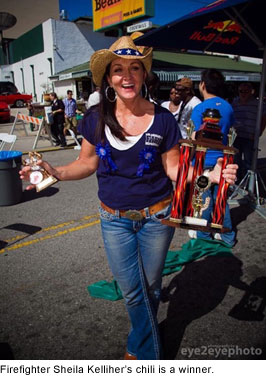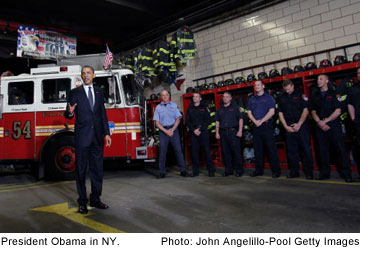L.A. firehouse food brings healthy heat
May 17, 2011
 When President Barack Obama lunched earlier this month at a fire station in Midtown Manhattan, he sat down to pasta in cream sauce and eggplant parmesan—traditional New York firehouse fare. Too bad for his waistline he didn’t roll West Coast-style with Sheila Kelliher and her fellow Los Angeles County firefighters.
When President Barack Obama lunched earlier this month at a fire station in Midtown Manhattan, he sat down to pasta in cream sauce and eggplant parmesan—traditional New York firehouse fare. Too bad for his waistline he didn’t roll West Coast-style with Sheila Kelliher and her fellow Los Angeles County firefighters.
“We do a lot of grilling,” says Kelliher, a firefighter-paramedic at West Hollywood’s Station 8, where the take on firehouse cuisine is a far cry from the carb-heavy comfort fests dished up at fire stations in other parts of the country.
“Chicken, fish, pita breads, salads. Eleven years ago, when I first came on the job, it was meat and potatoes, but now healthier food is the trend. At least it is here.”
Kelliher should know. Last month, her quietly healthy recipe for Texas chili won the Barney’s Beanery First Annual Five-Alarm Firefighter Chili Cook-Off, a region-wide contest launched by the restaurant in honor of its 90th anniversary.
The recipe—a secret concoction of grilled tri-tip, red sauce, “no extra fat and not too many black beans”—was so delicious, yet light, that, starting June 1, it will appear on the Barney’s Beanery menu. Proceeds will benefit the Alisa Ann Ruch Burn Foundation, a nonprofit for burn survivors.
“Her chili was just very flavorful, it wasn’t too heavy and it wasn’t overloaded,” says the restaurant’s regional manager A.J. Sacher in a description that firehouse food experts say could easily sum up the philosophy of Southern California firefighters.
“In Chicago, they’ll grind up four pounds of meat and put in some macaroni and call it dinner,” says Jeff Gatesman, the West Los Angeles producer of “Feeding the Fire,” a web-based TV cooking show featuring firefighter chefs from across the country.
“But it’s a whole different story in California. We just shot an episode in Santa Monica and the guy made, like, pan-seared sea bass.”
Firehouse cooking is a venerable institution, particularly in cities where firefighters bunk in the fire station for 24-hour shifts that last several days.
“They work together, they sleep together and they break bread together,” says R.G. “Bob” Adams, author of “Firehouse Cooking: Food From America’s Bravest,” an international compilation of firefighter recipes that he says has sold more than a million copies since its first publication in 1993.
“The chef in a firehouse is the hub,” says Adams. “Kind of like the mother in a family.”
And like mothers everywhere, firehouse chefs are stewards of a community’s priorities and sub-cultures, from ethnic traditions to attitudes about nutrition and weight.
Long Beach Fire Capt. Eddie Sell, who is developing a cooking show for television called “Firehouse Chefs,” says that because firefighters have increasingly reflected the diversity of cities, firehouse meals “open the door to a city’s customs, so that when we have to make emergency calls to peoples’ homes, things aren’t as foreign.”
Where an East Coast firehouse might specialize in Italian feasts and a Southern company might be famed for rich desserts and gumbos, Sell says, West Coast stations will line up for pho and fish tacos.
“And definitely, there’s more heart-healthy stuff on the West Coast,” adds Matt Jackson, a West Covina firefighter-paramedic whose year-old Company Chow blog has become a recipe clearinghouse for firefighters from New York to Hawaii.
“Some crews I’ve worked on, the guys will have, like, gluten-free diets, or they’re not eating any simple sugars. Last year, ‘Live! With Regis and Kelly’ had a firefighter barbecue cook-off, and the California firefighter’s entry was actually a salad with barbecued pears.”
 Kelliher, a Woodland Hills mother of 8-month old twins who does competitive bodybuilding in her spare time, says health is a priority at her station. (Check out one of her recipes here.)
Kelliher, a Woodland Hills mother of 8-month old twins who does competitive bodybuilding in her spare time, says health is a priority at her station. (Check out one of her recipes here.)
“Our county leads the charge when it comes to fitness,” she says. “We have a program called Fitness for Life. We have to pass a physical every year and meet certain benchmarks.
“And L.A. life is all about healthy lifestyle—a lot of our guys surf and snowboard and go to the river. Colder parts of the world, you don’t to do those things year-round, you’re covered up, maybe you eat more comfort food. But here, you hit the beach, the shirts come off and vanity kicks in.”
The 13 firefighters on her shift take turns at kitchen duty, she says: “Everybody puts in their money for chow—$12 for two meals, $7 for one meal—then whoever is the cook takes the money and goes to the store.”
All firehouse meals must meet two basic criteria, she says: “You can’t come up short, and it has to taste good.”
But health is a given, even for the younger firefighters who can eat as much bread as they want to. Grilling—which allows the fat to drip away from fish or meat during cooking—is such an art form at Station 8 that a few years ago, the whole crew chipped in and built an outdoor barbecue and grill station. “Everybody has their own specialty,” she says.
As for that special chili, she entered it in the contest at the behest of a friend, who knew it as something that Kelliher, who grew up in a family of Texas restaurateurs, served at Superbowl parties. Kelliher did her cooking off-duty and pressed her husband into helping her to serve massive quantities of the chili during the competition. It’ll be on the menu till September at all five of Barney’s Beanery locations in Los Angeles County.
Which may be the only chance her fellow crew members get to taste it. Ironically, she’s never served it at the firehouse. “It’s too labor intensive,” she said.
Posted 5/17/11












 405 bridge work causes a stink
405 bridge work causes a stink
